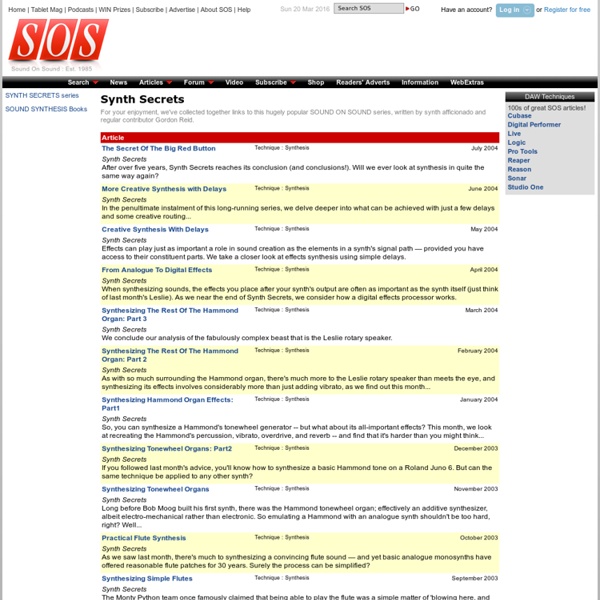



Famous Sounds An awesome sounding, expressive early electronic keyboard! --- Del Shannon's "Runaway", The Tornadoes' "Telstar" are examples of this precursor to the modern synthesizer. UPDATE FROM A READER: "Hiyas. You list the Del Shannon hit "runaway" as featuring a clavoline. That's not a clavoline, though. Several years ago, PBS ran a series called "The history of rock n' roll" - and one of the songs it touched on was Del Shannon's runaway. I searched google but was unable to find anyone who had this info posted, so your best bet is to try and hunt up a copy of that old PBS series, and view the interviews for yourself. cheers -cobalt* "
algorave Mashuptown.com Digital Reverb Explained Digital reverb simulates a natural or unnatural ambient space using a mathematical model aka algorithm. When an impulse signal (IE music) produces sound pressure in an ambient space surrounded by reflective surfaces, the sound propogates in all directions around the space then bounces off each of the surfaces to be returned to a position of listening reference. These multiple returns are called early reflections. They continue to bounce all over the room in an accumulative manner while decaying over time, forming diffuse or late reflections. These reflections mixed with the direct impulse signal defines reverb. There are many variables that shape the sound of the reverb. Much research has been done (and continues to this day) on deriving a mathematical model that allows an embedded system to emulate a natural ambient reverb. It would be convenient for the rest of us if we could use terms such as non-parallel wood walls, carpetted floor, arched open ceiling to define our reverb.
nm_filters [Prev (Oscillator Modification)][Next (Noise Generation)][Table of Contents] Much of the character of a given synthesizer sound comes from the filters that are used to sculpt the spectrum of the sound. While the Nord Modular provides a wide range of different filter modules, one can obtain an even wider array of filtering possibilities by applying various patch design techniques. 3.1 Resonant Filters as Oscillators Filters need not be used only for filtering. They can (in some cases) also be used to generate signals. The Classic filter on the Nord Modular can be made to oscillate if its resonance setting is high enough. With digital filters you have to give the filters a bit of a push to get them oscillating. The patch shown below uses two self-resonant F-filters (classic filters) with their resonant peaks slightly separated (controlled by an LFO). Figure 3.1. The patch shown below implements this idea. Figure 3.2. Resonant filters can also make good sources of drum sounds. Figure 3.3.
CommitCRM | Business Automation for Successful ITs download free electronic music » minimalistica The Ultimate Guide To Mixing Vocals Before we get started, I have to make it clear that this tutorial will work with whatever DAW you’re using. You could be mixing vocals in Pro Tools, FL Studio, Garageband, Cubase 5, Studio One or using any plugins whether Waves, UAD or stock plugins. This is a concise guide so it doesn’t matter what you’re using and if you have problems applying the knowledge then spend some time learning your software or plugins. As you may know I did a short post about mixing vocals in 4 easy steps and this time I want to give you something that is more detailed and help you learn how to make vocals stand out in a mix. I’m not going to cover anything related to recording as I’m going to make a post about that in the next coming days. The key to getting the right vocal mix is to make sure you get it right from the source. Now the 1st thing I do is listen to the vocals and try to get a rough picture of the final results in my mind. Gate Processing Tips Equalizing The Vocal Vocal Eq Settings Compression Tips